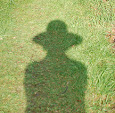As I am now spending more time in the car (the builders having arrived yesterday therefore we have de-camped permanently back to Helensburgh) I got an audio book out of the library to help me pass the time on the Milngavie-Helensburgh journey. Reception on the radio as one nears Helensburgh virtually disappears (on BBC Radio 4).
I make no apology for judging a book by its cover. My eye caught this! I have tried to read A S Byatt before and faltered early on - odd for me as I like what other people call 'heavy' books. Well ... I started listening to, and am really enjoying, this mega-audio book of 28 (!) CDs.
I make no apology for judging a book by its cover. My eye caught this! I have tried to read A S Byatt before and faltered early on - odd for me as I like what other people call 'heavy' books. Well ... I started listening to, and am really enjoying, this mega-audio book of 28 (!) CDs.
 It is all about a family, in England late 1890s to end of WW1, whose mother, the central character, is a teller/writer of fairy stories. What is emerging (as I have only just started) is that this is going to be about the Arts and Crafts Movement as well as how literary folk are often closely associated with socialist movements.
It is all about a family, in England late 1890s to end of WW1, whose mother, the central character, is a teller/writer of fairy stories. What is emerging (as I have only just started) is that this is going to be about the Arts and Crafts Movement as well as how literary folk are often closely associated with socialist movements.However, leaving aside the (dense!) story, what's the story of this cover? (That is the audio book case cover above.) Sourcing the image set me off-at-a-Google-tangent!
 It seems that this image is a piece of jewellery. "Dragonfly woman [female torso and griffin claws] corsage ornament (1897–1898). Gold, enamel, chrysoprase, moonstones, and diamonds." (1) It was made by glass artist and jeweller René Lalique (1860–1945) and was owned by wealthy Armenian collector Calouste Gulbenkian in whose museum [Lisbone, Portugal] it now resides (see below).
It seems that this image is a piece of jewellery. "Dragonfly woman [female torso and griffin claws] corsage ornament (1897–1898). Gold, enamel, chrysoprase, moonstones, and diamonds." (1) It was made by glass artist and jeweller René Lalique (1860–1945) and was owned by wealthy Armenian collector Calouste Gulbenkian in whose museum [Lisbone, Portugal] it now resides (see below).The above photo was taken by a member of the public. (2) I can't figure out the size! As a corsage, it looks extremely big! I see it has hinges on the wings.
I spent ages looking at other jewellery (and glass) by this amazing man here . And that lead me to see the role that Sarah Bernhardt played in all of this.
 Lalique was "introduced ... to Sarah Bernhardt in the mid-1890's. [He] then began designing spectacular stage jewelry for Bernhardt, whose flair for the dramatic influenced his creative design for years.
Lalique was "introduced ... to Sarah Bernhardt in the mid-1890's. [He] then began designing spectacular stage jewelry for Bernhardt, whose flair for the dramatic influenced his creative design for years.It is believed that Lalique's friendship with Bernhardt introduced him to Calouste Gulbenkian, an art collector from Lisbon. Gulbenkian's enthusiasm for Lalique's talents became the chance of a lifetime for the artist. Gulbenkian's commissioning of 145 jeweled objects made him Lalique's major patron from 1895 until about 1912. Free of financial concern and able to design at will, Lalique entered the most creative period of his jewelry career. Gulbenkian's collection today is the biggest repository of Lalique's art." (3)
_____________________________________________________________
(1) Website here.
(2) Website is here.
(3) Website here.




1 comment:
What an interesting post. The jewelry is lovely – what beautiful design. My father was a jeweler too and he created his own designs, but they were in the 40s and 50s styles. When we went to Lisbon going to the Gulbenkian museum was a priority – there was so much to see. It is a beautiful museum. Lisbon owes Gulbenkian a lot in the matter of the arts.
Post a Comment